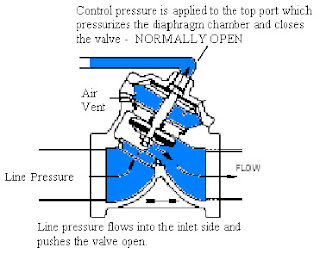That brings us to the question: what does Normally Open and Normally Closed mean when speaking about Aquamatic Valves. Aquamatic valves are controlled specifically by pressure. Even more so, line pressure from either water or air flowing into the valve, and control pressure, which comes from an Aquamatic Stager Controller or some type of solenoid. Lets take a look at how one can determine if their valves are normally open or normally closed.
So how does a Normally Open Aquamatic Valve work?
In the Aquamatic world, a Normally Open Valve means when water or air passes through the inlet side of an Aquamatic Valve, the Aquamatic Valve will open to allow the water or air to flow through it. More simply put, in a Normally Open configuration, line pressure opens the valve, and control pressure closes the valve.
So, the only way to close this valve is to apply control pressure into the Aquamatic Valve’s diaphragm chamber through the control port on top of the valve cap. This control pressure can be either water or air, and the pressure has to be equal or greater than the line pressure. Equal pressure will close the valve because the surface area of the diaphragm chamber is greater than the surface area of the inlet hole of the valve.
Here is a diagram showing the function of a Normally Open Valve:

In looking at the diagram, water flowing into the valve, will open up the valve in a Normally Open valve configuration, and the control pressure applied to the diaphragm, chamber will close the valve. From a visual standpoint, if one sees a small tubing line connected to the top of the Aquamatic Valve’s cap, that is a good indication the valve is Normally Open.
So how does a Normally Closed Aquamatic Valve work?
A Normally Closed Valve means when water or air passes through the inlet side of an Aquamatic Valve, the Aquamatic Valve will close stopping the flow of water or air. Said another way, in a Normally Closed configuration, line pressure closes the valve, and control pressure opens the valve.
There is a shaft inside the Aquamatic Valves that holds the other parts in place. A Normally Closed Valve has a hollow shaft. The hollow shaft allows the line pressure, water or air, to flow up the shaft into the diaphragm chamber. This pressurizes the diaphragm chamber, which then push the parts down closing the Aquamatic Valve. A pipe plug is inserted in the port on top of the valve cap to keep the water or air pressure from escaping the valve. In order to open up this valve, control pressure is applied to a port that is typically located underneath the valve cap, which forces the valve in the open stage. Here is a diagram showing how a Normally Closed Valve functions:
The best way to determine if the valve is normally closed is to see if a pipe plug inserted on the valve cap.
How can Res-Kem help me?
Hopefully, I have been able to explain the difference between Normally Open or Normally Closed AquaMatic valves. If not, we usually recommend you email pictures to me. Res-Kem also offers question forms with visuals to also assist.
AquaMatic K52 Series Question Guide
AquaMatic K530 Series Question Guide
AquaMatic V42 Series Question Guide
AquaMatic VAV Series Question Guide
Also look at our videos of how to select and repair AquaMatic valves.
If you have any questions, please email me, Mike Polito, or contact me for further assistance at 800-323-1983.

No comments:
Post a Comment